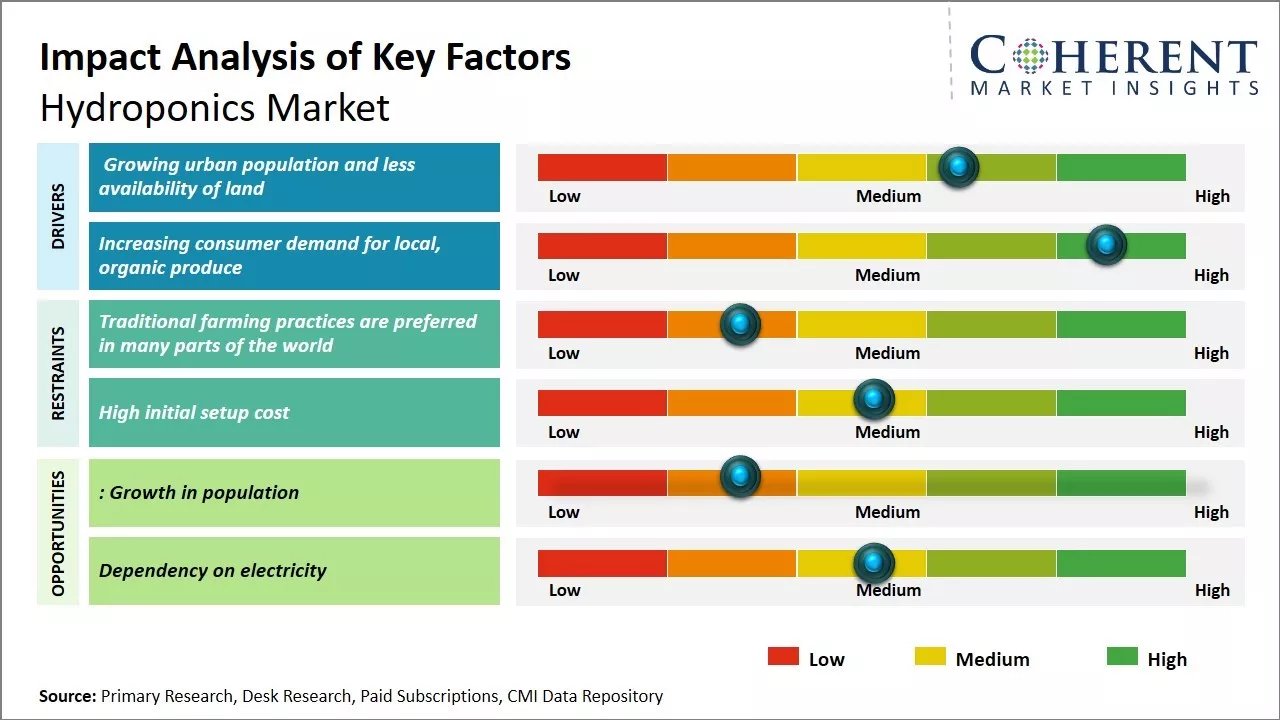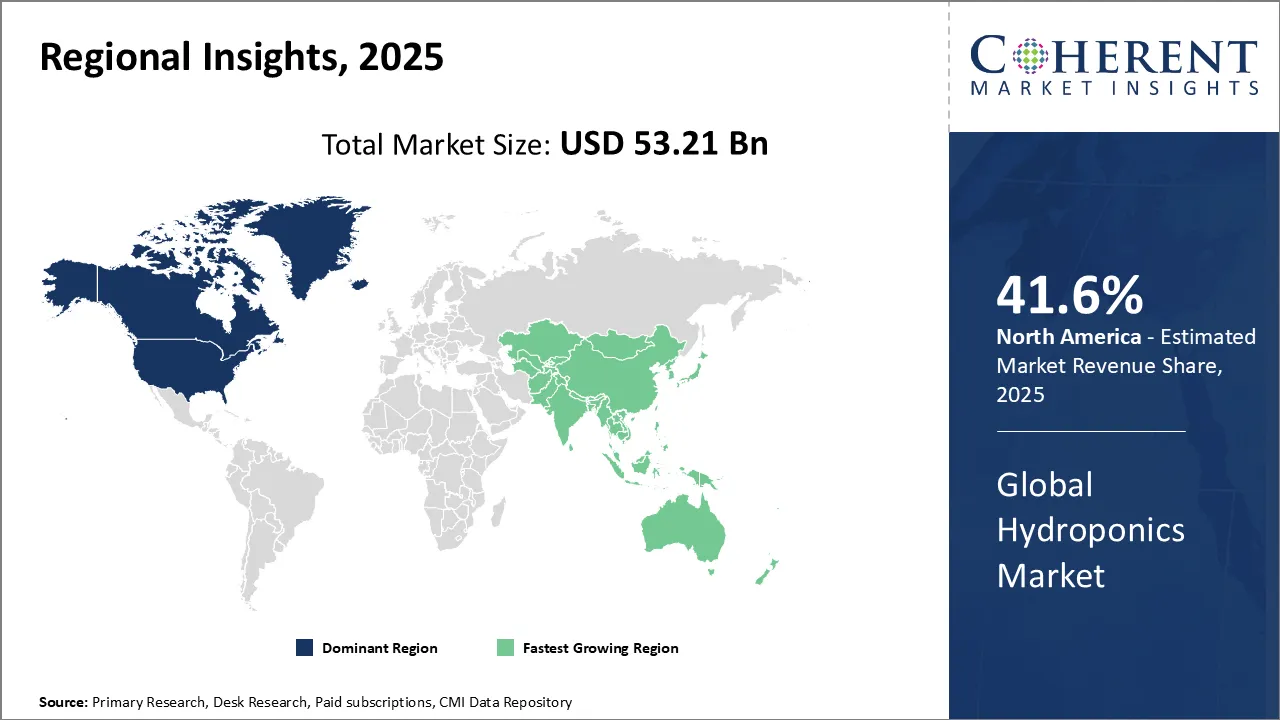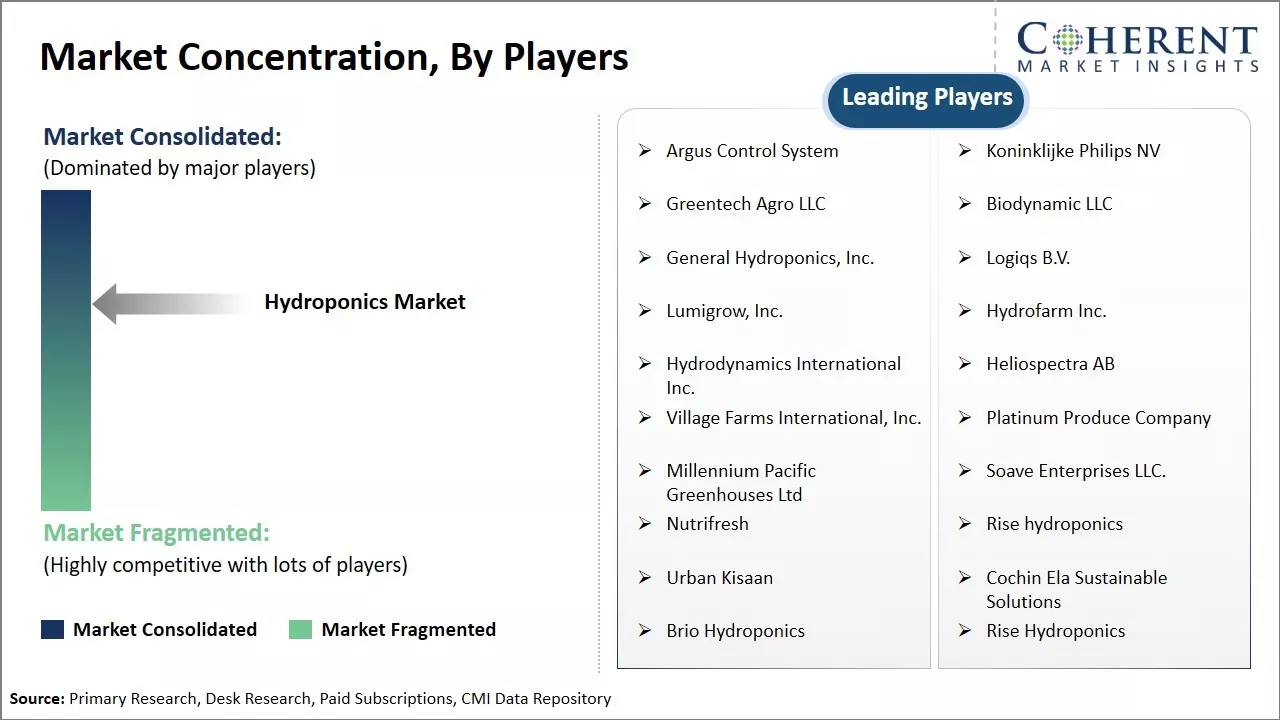The hydroponics market is estimated to be valued at USD 53.21 Bn in 2025 and is expected to reach USD 119.93 Bn by 2032, growing at a compound annual growth rate (CAGR) of 12.3% from 2025 to 2032.

To learn more about this report, Download Free Sample
The growing popularity of organic foods and the need for alternative farming practices are expected to drive hydroponics market demand during the forecast period. Consumers are increasingly looking for organically grown leafy greens and vegetables due to rising health concerns regarding the chemicals used in traditional farming. Moreover, hydroponic farming provides higher yields while using less water and fertilizers, making it a more sustainable option. With diminished agricultural land and water resources, hydroponics is emerging as a solution to fulfill the growing demand for fresh produce. Further, technological advancements in hydroponics equipment and expanded applications in urban farming are likely to boost the adoption of hydroponic solutions in the coming years.
|
Current Event |
Description and its Impact |
|
Organic Certification Controversy and Regulatory Evolution |
|
|
Venture Capital Drought and Investment Landscape Transformation |
|
Uncover macros and micros vetted on 75+ parameters: Get instant access to report
Artificial Intelligence plays a pivotal role in transforming hydroponic agriculture by automating key processes such as nutrient delivery, pH regulation, lighting schedules, and climate control. Through real-time data analytics and sensor integration, AI systems can monitor plant health, predict growth patterns, and adjust environmental conditions to optimize yields. This reduces human intervention and resource waste, making hydroponic farming more cost-effective and eco-friendlier. In commercial setups, AI-driven platforms enable precision farming at scale, while in urban environments, smart hydroponic units, often powered by AI that allow individuals to grow fresh produce indoors with minimal effort. As highlighted in recent hydroponics market research, AI integration is also driving innovation in equipment design, predictive maintenance, and crop forecasting, positioning hydroponics as a cornerstone of climate-resilient agriculture.
For instance, in March 2025, Chennai-based agritech startup Croppico unveiled Homie, an AI-powered smart hydroponics system tailored for urban indoor farming. The compact device automates crop care using artificial intelligence, enabling year-round, pesticide-free produce with minimal effort. Homie promotes sustainable living and food security in densely populated cities.
In terms of equipment, the LED grow light segment contributes 47% share of the market in 2025. Their popularity stems from their energy efficiency, long lifespan, and ability to provide tailored light spectrums that optimize plant growth. Unlike traditional lighting systems, LEDs emit minimal heat, reducing the need for extensive cooling systems and allowing growers to maintain ideal conditions in compact indoor setups. As urban farming and vertical agriculture expand, LED technology has become indispensable for maximizing yield in limited spaces.
For instance, in May 2025, Hydroponics system manufacturer SuperCloset launched its new “Kind” LED grow lights, engineered to optimize flowering and boost large crop yields. The advanced lighting technology enhances indoor farming efficiency, offering growers a powerful tool for sustainable, high-output cultivation.
In terms of type, the aggregate system segment is expected to hold the largest share of the market in 2025. These systems use inert media like perlite, vermiculite, or coco coir to support plant roots while delivering nutrients through drip or flood-and-drain methods. Their simplicity, scalability, and adaptability to various crops make them a favorite among commercial growers and hobbyists alike. Aggregate systems are particularly effective for leafy greens and fruiting vegetables, offering a balance between automation and manual control that appeals to a wide range of users.
In terms of crop type, the lettuce & leafy vegetables segment is projected to account for the highest share of the market in 2025, due to their fast growth cycles, high consumer demand, and suitability for controlled environments. These crops thrive in hydroponic systems, especially in nutrient film technique (NFT) and deep-water culture setups, which provide consistent nutrient delivery and oxygenation. Their lightweight structure and short harvest intervals make them ideal for urban farms and commercial operations aiming for quick turnover and profitability.
For instance, in May 2024, a new smart hydroponic farming system enabled urban dwellers to grow fresh greens and herbs at home year-round. Compact, automated, and soil-free, it uses LED lighting and nutrient-rich water to produce pesticide-free crops, making sustainable farming accessible to city residents.
In terms of input type, the grow media segment is expected to capture the greatest share of the market in 2025. The grow media materials provide essential support for plant roots while facilitating efficient water and nutrient absorption. Rockwool, in particular, is favored for its excellent moisture retention and sterile nature, reducing the risk of pests and diseases. As hydroponic systems evolve, the demand for high-performance grow media continues to rise, driving innovation in substrate composition and sustainability.

To learn more about this report, Download Free Sample
North America has established itself as the dominant region in the global hydroponics market. With the extensive adoption of hydroponic farming practices across different application sectors such as indoor and outdoor farming, the region accounts for over 41.6% of the worldwide hydroponics market share. Farmers in the region have widely adopted sophisticated hydroponic greenhouse systems to cultivate crops throughout the year without being dependent on seasonal variations or climatic conditions.
For instance, in October 2025, Fairview South School in the U.S. unveiled a USD 3.5 million renovation, launching a hydroponic farming program tailored for students with special needs. The initiative integrates hands-on agricultural learning with modern technology, promoting sustainability, life skills, and inclusive education.
Apart from the existing mature markets, Asia Pacific has emerged as a high-growth hotspot in the global industry. The ASEAN region has seen massive increase in indoor hydroponic farming to fulfill the rising demand for fresh produce from densely populated cities. Countries like Thailand, Malaysia, and Indonesia are attracting major investments from leading equipment manufacturers to tap into the fast-evolving urban agriculture trend. The adoption of hydroponics is mainly driven by the need to optimize limited land resources and explore new revenue streams from high-value organic crops. Thai hydroponic farmers have particularly focused on herbs, leafy vegetables, and organic strawberries for both domestic consumption and exports to Western markets.
For instance, in May 2025, a modular vertical farming system developed in Malaysia launched in Kazakhstan, aiming to boost local food production. The innovative setup offers scalable, soil-free cultivation using hydroponics, supporting sustainable agriculture and reducing dependency on imported produce.
The U.S. remains a global leader in hydroponics adoption, especially in urban centers and tech-driven agriculture hubs. Demand is fueled by consumer preference for pesticide-free produce, the rise of vertical farming startups, and government support for sustainable food systems. States like California, New York, and Arizona are hotspots for commercial hydroponic farms.
For instance, in October 2025, NY Sun Works launched its latest hydroponics classroom at the Bronx School for Technology Applications, empowering students with hands-on experience in sustainable farming. The initiative integrates STEM education with urban agriculture, promoting environmental awareness and food literacy among youth.
India is emerging as a major player in hydroponics, driven by rising health awareness, water scarcity, and the need for year-round crop production. Startups and agritech companies are promoting hydroponic solutions for leafy greens, herbs, and exotic vegetables. Cities like Bengaluru, Pune, and Hyderabad are seeing increased adoption in both commercial and residential setups.
For instance, in October 2025, Brio Hydroponics, in collaboration with Unnati, launched a strategic initiative to promote climate-smart agriculture across India. The partnership aims to empower farmers with hydroponic technology, enhancing sustainability, crop resilience, and resource efficiency amid growing environmental challenges.
| Report Coverage | Details | ||
|---|---|---|---|
| Base Year: | 2024 | Market Size in 2025: | USD 53.21 Bn |
| Historical Data for: | 2020 To 2024 | Forecast Period: | 2025 To 2032 |
| Forecast Period 2025 to 2032 CAGR: | 12.3% | 2032 Value Projection: | USD 119.93 Bn |
| Geographies covered: |
|
||
| Segments covered: |
|
||
| Companies covered: |
Argus Control System, Koninklijke Philips NV, Greentech Agro LLC, Biodynamic LLC, General Hydroponics, Inc., Logiqs B.V., Lumigrow, Inc., Hydrofarm Inc., Hydrodynamics International Inc., Heliospectra AB, Village Farms International, Inc., Platinum Produce Company, Millennium Pacific Greenhouses Ltd, Soave Enterprises LLC., Nutrifresh, Rise hydroponics, Urban Kisaan, Cochin Ela Sustainable Solutions, Brio Hydroponics, and Rise Hydroponics |
||
| Growth Drivers: |
|
||
| Restraints & Challenges: |
|
||
Uncover macros and micros vetted on 75+ parameters: Get instant access to report
With urban populations rising globally, traditional farming near cities is becoming unsustainable due to shrinking land and high rental costs. According to the United Nations, 68% of the world will live in urban areas by 2050. Hydroponic farming offers a climate-smart solution, enabling crops to grow indoors in stacked layers using minimal land and water. These systems can be installed on rooftops, in warehouses, or containers near consumption points, reducing logistics costs and food waste. With controlled environments, year-round harvesting becomes feasible. Hydroponics Market research highlights its growing relevance in urban agriculture, addressing food security and sustainability challenges in densely populated regions.

To learn more about this report, Download Free Sample
The hydroponics market forecast reveals a surge in global demand, driven by population growth and the need for efficient, year-round food production. Hydroponics enables higher yields on limited land, making it ideal for urban and vertical farming. As consumers increasingly seek pesticide-free local produce, the market is responding with more affordable, user-friendly technologies. These innovations are unlocking new opportunities for both commercial growers and home-based systems, positioning hydroponics as a cornerstone of climate-smart agriculture.
The hydroponics market value is transitioning from a niche technique to a vital component of modern agriculture, driven by its ability to deliver higher yields with minimal land and water use. Integration of AI, IoT sensors, and data analytics has transformed hydroponic farms into precision-controlled production systems. Companies such as Priva and AeroFarms now achieve up to 30% higher yields through optimized nutrient and light management, highlighting technology as the key differentiator.
Governments are aligning hydroponics with national food security goals. In Singapore, vertical farms like Sustenir Agriculture use 95% less water than traditional farming, showcasing its urban sustainability potential. Likewise, the UAE is incentivizing large-scale hydroponic adoption to enhance domestic food resilience.
Falling costs of LEDs and sensors, down nearly 60% over the past decade are making hydroponics more financially viable. Partnerships such as Walmart’s collaboration with Plenty demonstrate its integration into mainstream retail supply chains, ensuring fresh, local produce.
Industry consolidation is accelerating, with players like General Hydroponics forming turnkey partnerships across inputs and automation. Ultimately, hydroponics stands as a structural shift toward sustainable, tech-enabled, and localized food production, aligning with global priorities of climate resilience, food sovereignty, and urban self-sufficiency.
Share
Share
About Author
Yash Doshi is a Senior Management Consultant. He has 12+ years of experience in conducting research and handling consulting projects across verticals in APAC, EMEA, and the Americas.
He brings strong acumen in helping chemical companies navigate complex challenges and identify growth opportunities. He has deep expertise across the chemicals value chain, including commodity, specialty and fine chemicals, plastics and polymers, and petrochemicals. Yash is a sought-after speaker at industry conferences and contributes to various publications on topics related commodity, specialty and fine chemicals, plastics and polymers, and petrochemicals.
Missing comfort of reading report in your local language? Find your preferred language :
Transform your Strategy with Exclusive Trending Reports :
Frequently Asked Questions
Joining thousands of companies around the world committed to making the Excellent Business Solutions.
View All Our Clients